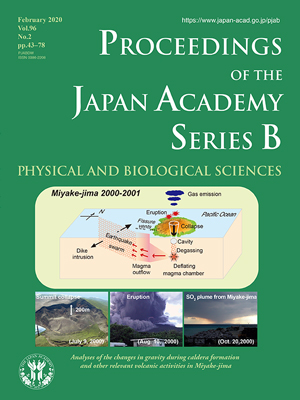About the Cover
Vol. 96 No. 2 (2020)
Miyake-jima is a circular volcanic island on the Izu–Bonin arc in the northwestern Pacific. Historical records show that magmatic eruptions occurred every 20 to 60 years since the 18-th century. The most recent volcanic unrest occurred in 2000 and was characterized by the spectacular succession of the collapse of the summit in July, phreatic eruptions in August, and emission of huge amount of volcanic gases (10000–50000 tons/day of SO2) for more than a year since late August 2000. This volcanic event provided earth scientists with a rare opportunity to observe the formation of a caldera using geophysical methods.
Among them, the gravity measurements conducted during the event by Prof. Shuhei Okubo and colleagues were important to understand the subsurface mass transport in and around Miyake-jima (Okubo 2020, this issue, pp. 50–69). An unusually large decrease in gravity was observed on July 6, 2000, indicating a mass loss equivalent to a cavity having a diameter of 500 m at a depth of 1.7 km. Two days after this discovery, i.e., on July 8, the summit of the volcano collapsed by 200 m to form a pit crater having a diameter of 800 m (lower left, courtesy of Prof. Setsuya Nakada), which was comparable in size to the presupposed cavity. The gravity analysis conducted on July 11, three days after the collapse, implied that huge unfilled space remained below the collapsed summit. As expected, the pit crater steadily grew to form a caldera having a diameter of 1600 m by the end of September 2000. In addition, gravity analysis provided a constraint wherein the huge volume of newly-formed caldera (0.6 km3) was transported from Miyake-jima; the most probable destination coincided with a zone at which a tensile opening of 6 m was supposedly present in the crust. It implies the large-scale lateral transport of magma over a long distance of 30 km. Meanwhile, the degassing of the volatile gases (SO2 and H2S) was accelerated (lower right) partly because the pressure imposed on the magma head in the conduit was significantly reduced by the removal of rocks above the magma head and partly because the island’s aquifer around the sea level was destroyed by the frequent phreatic eruptions (lower center).
Hidefumi Watanabe
Professor Emeritus, The University of Tokyo




